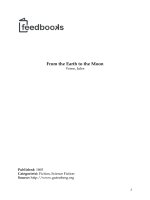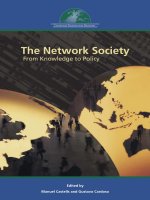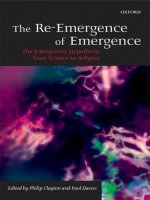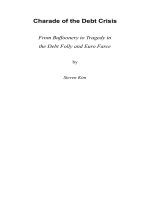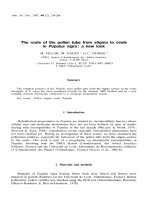Discovering the earth animals from mythology to zoology
Bạn đang xem bản rút gọn của tài liệu. Xem và tải ngay bản đầy đủ của tài liệu tại đây (10.71 MB, 224 trang )
AnimAls
From Mythology to Zoology
Animals
From Mythology to Zoology
Michael Allaby
Illustrations by Richard Garratt
ANIMALS: From Mythology to Zoology
Copyright © 2010 by Michael Allaby
All rights reserved. No part of this book may be reproduced or utilized in any form or by any means,
electronic or mechanical, including photocopying, recording, or by any information storage or
retrieval systems, without permission in writing from the publisher. For information contact:
Facts On File, Inc.
An imprint of Infobase Publishing
132 West 31st Street
New York NY 10001
Library of Congress Cataloging-in-Publication Data
Allaby, Michael.
Animals: from mythology to zoology / Michael Allaby; illustrations by Richard Garratt.
p. cm.—(Discovering the Earth)
Includes bibliographical references and index.
ISBN-13: 978-0-8160-6101-3 (hardcover)
ISBN-10: 0-8160-6101-7 (hardcover)
ISBN: 978-1-4381-2745-3 (e-book)
1. Animals—Popular works. 2. Animals—Mythology—Popular works. 3. Zoology—Popular works.
I. Title.
QL50.A395 2010
590—dc22
2009006194
Facts On File books are available at special discounts when purchased in bulk quantities for
businesses, associations, institutions, or sales promotions. Please call our Special Sales Department
in New York at (212) 967-8800 or (800) 322-8755.
You can find Facts On File on the World Wide Web at tsonfi le.com
Excerpts included herewith have been reprinted by permission of the copyright holders; the author
has made every effort to contact copyright holders. The publishers will be glad to rectify, in future
editions, any errors or omissions brought to their notice.
Text design by Annie O’Donnell
Illustrations by Richard Garratt
Photo research by Tobi Zausner, Ph.D.
Composition by Hermitage Publishing Services
Cover printed by Creative Printing
Book printed and bound by Creative Printing
Date printed: December, 2009
Printed in China
10 9 8 7 6 5 4 3 2 1
This book is printed on acid-free paper.
xiv+212_DTE-Animals.indd 4
2/11/10 2:19:54 PM
CONTENTS
Preface
ix
Acknowledgments
xi
Introduction
xii
1
3 CHAPTER
WHERE DO ANIMALS COME FROM?
1
The Elements
2
Epicurus and Animals That Emerge from the Ground
4
Nature the Creator
7
Animals Designed for the Ways They Live
9
The Servants of People
11
The Modern Concept of Adaptation
2
3 CHAPTER
THE BEGINNING OF SCIENCE
14
Plato and the World of Ideas
15
Aristotle and the Importance of Observation
18
Pliny, Collector of Information
21
The Death of Pliny
3
3 CHAPTER
MENAGERIES AND ZOOS
27
King Wen and His Garden of Intelligence
28
Marco Polo and the Gardens of Kinsai
29
Marco Polo at Xanadu
34
Queen Hatshepsut and the First Expedition to Collect Animals
36
Solomon’s Monkeys and Nebuchadrezzar’s Lions
38
Greek Bird Gardens
39
Roman Pets, Menageries, and Circuses
43
The Menagerie of Octavius Augustus
44
The Difference between a Menagerie and a Zoo
Nero and the Grounds of His Golden House
47
Henry I and the First English Menagerie
48
King John and His Menagerie at the Tower of London
51
The Royal Menagerie at Versailles
55
4
3 CHAPTER
TRAVELERS’ TALES
59
Moral Lessons to Be Drawn from Animal Behavior
60
Bestiaries
61
How Doth the Little Busy Bee
63
Hedgehog
65
Fox
67
Weasel
67
Pelican
68
Eagle
70
Elephant
71
Viper
73
Crocodile
73
Barnacles
75
Captain Hunter, Thomas Bewick, and the
Duck-billed Platypus
77
5
3 CHAPTER
FANTASTIC BEASTS
81
Manticora
82
Dragons
83
Basilisk
85
Onocentaur
87
Siren
87
Satyr
88
Phoenix
89
Amphisbaena
90
Hydrus
91
Caladrius
93
6
3 CHAPTER
FANTASTIC HUMANS
94
Dog-headed Men
95
Blemmyes, Cyclops, Sciapodae, and Panotii
97
7
3 CHAPTER
OBSERVATION AND UNDERSTANDING
101
Conrad Gessner, the Swiss Pliny
101
Pierre Belon, and the Skeletons of Birds and Mammals
104
Homology, Analogy, Orthology, and Paralogy
Guillaume Rondelet and the Study of Fishes
108
8
3 CHAPTER
CLASSIFYING AND EXPERIMENTING
110
John Ray and Francis Willughby
111
The Invention of the Microscope
112
Robert Hooke: England’s Leonardo?
Malpighi and the Anatomists
116
Francesco Redi and Spontaneous Generation
119
Descartes and Mechanical Animals
120
Linnaeus and the Beginning of Modern Classification
123
Carl von Linné: Binomial Nomenclature
Modern Classification
9
3 CHAPTER
GENERATION, SPECIES, AND EVOLUTION
127
Preformation
127
Charles Bonnet and How Aphids Reproduce
129
Abraham Trembley and the Polyp
131
Comte de Buffon and His Natural History
134
Jean-Baptiste Lamarck and Adaptive Evolution
135
Erasmus Darwin and the Progress of Life
137
Charles Robert Darwin and Evolution by Means
of Natural Selection
10
3 CHAPTER
GENETICS AND RELATIONSHIPS
139
143
Gregor Mendel and His Peas
144
August Weismann and the Rejection of Lamarck
147
Wilhelm Johannsen and the Gene
149
William Bateson and Balanoglossus
150
Discovery of the Double Helix
151
The Universal Genetic Code
The Central Dogma
Genomes and Evolutionary Trees
155
Eugenics
11
3 CHAPTER
ANIMAL BEHAVIOR
160
Red in Tooth and Claw
160
Sir John Lubbock and the Social Insects
162
Social Darwinism
Max Verworn, Jacques Loeb, and Responses to Stimuli
165
C. Lloyd Morgan and His Canon
167
Ivan Pavlov and Conditioned Responses
169
Instinct and Drive
Konrad Lorenz and Imprinting
171
Niko Tinbergen and Defending Territory
174
Karl von Frisch and the Dances of the Honeybee
176
Cameras, Radio Collars, and Event Recorders—Modern
Behavior Studies
179
Conclusion
Glossary
Further Resources
Index
PREFACE
A
lmost every day there are new stories about threats to
the natural environment or actual damage to it, or about measures that have been taken to protect it. The news is not always bad.
Areas of land are set aside for wildlife. New forests are planted. Steps
are taken to reduce the pollution of air and water.
Behind all of these news stories are the scientists working to
understand more about the natural world and through that understanding to protect it from avoidable harm. The scientists include
botanists, zoologists, ecologists, geologists, volcanologists, seismologists, geomorphologists, meteorologists, climatologists, oceanographers, and many more. In their different ways all of them are
environmental scientists.
The work of environmental scientists informs policy as well
as providing news stories. There are bodies of local, national, and
international legislation aimed at protecting the environment and
agencies charged with developing and implementing that legislation.
Environmental laws and regulations cover every activity that might
affect the environment. Consequently every company and every citizen needs to be aware of those rules that affect them.
There are very many books about the environment, environmental protection, and environmental science. Discovering the Earth is
different—it is a multivolume set for high school students that tells
the stories of how scientists arrived at their present level of understanding. In doing so, this set provides a background, a historical
context, to the news reports. Inevitably the stories that the books tell
are incomplete. It would be impossible to trace all of the events in the
history of each branch of the environmental sciences and recount the
lives of all the individual scientists who contributed to them. Instead
the books provide a series of snapshots in the form of brief accounts
of particular discoveries and of the people who made them. These
stories explain the problem that had to be solved, the way it was
approached, and, in some cases, the dead ends into which scientists
were drawn.
ix
x
ANIMALS
There are seven books in the set that deal with the following
topics:
3
3
3
3
3
3
3
Earth sciences,
atmosphere,
oceans,
ecology,
animals,
plants, and
exploration.
These topics will be of interest to students of environmental studies,
ecology, biology, geography, and geology. Students of the humanities
may also enjoy them for the light they shed on the way the scientific
aspect of Western culture has developed. The language is not technical, and the text demands no mathematical knowledge. Sidebars
are used where necessary to explain a particular concept without
interrupting the story. The books are suitable for all high school ages
and above, and for people of all ages, students or not, who are interested in how scientists acquired their knowledge of the world about
us—how they discovered the Earth.
Research scientists explore the unknown, so their work is like a
voyage of discovery, an adventure with an uncertain outcome. The
curiosity that drives scientists, the yearning for answers, for explanations of the world about us, is part of what we are. It is what makes
us human.
This set will enrich the studies of the high school students for
whom the books have been written. The Discovering the Earth
series will help science students understand where and when ideas
originate in ways that will add depth to their work, and for humanities students it will illuminate certain corners of history and culture
they might otherwise overlook. These are worthy objectives, and the
books have yet another: They aim to tell entertaining stories about
real people and events.
—Michael Allaby
www.michaelallaby.com
ACKNOWLEDGMENTS
A
ll of the diagrams and maps in the Discovering the Earth
books were drawn by my colleague and friend Richard Garratt.
As always, Richard has transformed my very rough sketches into finished artwork of the highest quality, and I am very grateful to him.
When I first planned these books, I prepared for each of them a
“shopping list” of photographs I thought would illustrate them. Those
lists were passed to another colleague and friend Tobi Zausner who
found exactly the pictures I felt the books needed. Her hard work,
enthusiasm, and understanding of what I was trying to do have
enlivened and greatly improved all of the books. Again I am deeply
grateful.
Finally, I wish to thank my friends at Facts On File, who have read
my text carefully and helped me improve it. I am especially grateful
for the patience, good humor, and encouragement of my editor, Frank
K. Darmstadt, who unfailingly conceals his exasperation when I am
late, laughs at my jokes, and barely flinches when I announce I am off
on vacation. At the very start, Frank agreed this set of books would
be useful. Without him they would not exist at all.
xi
INTRODUCTION
P
eople share the world with a bewildering variety of
nonhuman animals, and throughout history people have been
trying to understand the animals around them. Clearly, some of them
resemble humans in certain respects, and it seems entirely natural to
attribute to them feelings, thoughts, and motives that a human might
have. Some animals help humans, some steal from them, some are
dangerous, and all of them are interesting. Where did animals come
from? Why do they exist? This book describes a few of the changing
ideas that have shaped the way people see the world of animals, and
it tells of some of the research that has revealed their physiology and
explained their evolution and behavior.
Animals, one volume in the Discovering the Earth set, begins the
story in ancient Greece, at a time when thinkers were trying to construct a coherent image of the universe. They needed to make sense
of the world around them, and the earliest theories explaining the
origins of animals were drawn from the experiences of hunters. As
they debated and argued, speculated and theorized, the Greek philosophers came to realize that careful observation of what really happens is the only basis for a true understanding of the natural world.
With that realization they laid the foundation of what would become
a scientific approach to phenomena.
Since ancient times, animals have also been symbols of human
qualities. Lions are brave, foxes sly, serpents treacherous. The wealthy
and powerful, especially rulers, collected animals, sometimes sending
expeditions into remote regions for that purpose. They kept them to
entertain and impress others, as symbols of their power and the geographical extent of their dominions. Eventually, the animals held in
royal menageries became the founding stock for zoological gardens,
where they provided entertainment and educational instruction to
ordinary people and, more recently, became subjects for zoological
research and conservation.
Animals served as more than status symbols. They and their
behavior provided moral lessons. This book describes some of the
xii
Introduction
moral tales that were woven around animals in the Middle Ages.
The authors of those tales had not visited the lands inhabited by the
animals they described, so they had only the accounts of sailors and
adventurers to guide them. Not surprisingly, many of their written
descriptions and illustrations bore little relation to the actual animals, and some of the animals did not exist at all—indeed, they were
biologically impossible. As though descriptions of fantastic animals
were not enough, medieval writers also described fantastic people
living in distant lands. This book also describes a few of these.
Moralizing myths eventually gave way to more accurate depictions, and the book continues with an outline of their development. It
describes how naturalists studied the physiology of animals and the
techniques they devised for classifying them. Their work expanded
when the invention of the microscope gave them access to the world
of the very small, allowing them to watch minute animals and to
examine the detailed structure of larger animals.
Animal classification led to theories about the origin of animal
species. This led, by the th century, to the growing recognition
that modern species were the descendents of earlier species that were
different in important respects. The book tells how ideas about the
evolution of species developed and how the mechanism of heredity
was revealed. It describes the discovery of the gene and the physical
structure of DNA and how the genetic constitution of species came
to be used to determine their relationships.
Finally, the book turns to the study of animal behavior. It describes
the work of some of the pioneers in this field and the aspects of
behavior they investigated. It tells of the conditioned responses of
Pavlov’s dogs, the dance of the honeybee, and more.
People have been thinking about and studying animals for thousands of years. In the course of that long history they have accumulated vast amounts of information and, today, when the tools available
to scientists are more powerful than they have ever been, information
is arriving at an ever-faster rate. Even if it were possible to compress
all of that information, or even a comprehensive summary of it, into a
single volume, the result would be unwieldy and confusing. Animals
makes no such pretence—it amounts to nothing more than a series
of snapshots providing brief glimpses of some of the events that
have led to the present scientific understanding of animals and short
xiii
xiv
ANIMALS
accounts of the lives of a few of the remarkable individuals who have
contributed to that understanding. The book has a glossary defining
the technical terms used in the text, and for readers who would like
to pursue the subject further there is a list of books and Web sites
where they will be able to learn more.
1
Where Do Animals
Come From?
A
nimals—or as modern scientists would say nonhuman
animals—share the world with us, and they are everywhere.
Insects, spiders, and mice take up residence in human dwellings, and
no one is ever very far from a rat. People share their homes with companion animals—pets—that have learned to accommodate themselves to human ways. Dogs, first welcomed as hunting partners, have
lived with people for about , years. Cats came indoors about
, years ago, probably when children adopted orphaned kittens
that grew up with a taste for the comforts of the fireside and scraps
from the table. Previously, they earned their living hunting mice and
rats in grain stores close to human dwellings. To a bird, a tall building
is equivalent to a precipice, providing nesting sites and, for peregrine
falcons (Falco peregrinus), perches from which to dive onto prey.
From the earliest times, people have lived with nonhumans and
wondered about them. How did they originate? Every culture has a
story describing the origin of humans, but what about nonhumans?
Throughout history, many people have believed that humans possess
souls that continue to exist after the body has died. Do nonhumans
have similar souls?
Modern Western science began in ancient Greece. This chapter
describes Greek ideas about the origin of animals and compares
these with the beliefs of ancient Egypt and of some Native American
peoples.
1
2
ANIMALS
THE ELEMENTS
Scholars accept that Greek philosophy began with a school of thinkers, the first of whom was Thales of Miletus (ca. – ...).
Miletus was a Greek trading city on the coast of what is now Turkey.
Since long before Thales, however, Greeks had pondered and speculated about how the world they saw around them came to be the way
it was. They sought to explain things, and to do so they needed to
discover the basic substance from which everything is made. Prior to
Thales, the Greeks had attributed everything to the actions of supernatural beings. Thales rejected this idea, insisting that natural objects
and phenomena had natural, not supernatural, explanations. He was
compelled to do so, because supernatural explanations ultimately
lead nowhere. If a god fashioned sheep, cattle, and other animals,
which god was it? And why did the god make them? How did the god
come to live in the sky or the forests in the first place? The questions
go on forever, and in the end the answers tell people nothing useful
about the animals they are supposed to be describing.
Thales sought explanations for the world. He believed that water
was the most fundamental substance of all. He taught that the Earth
floats on water and that earthquakes are caused by waves in the cosmic
ocean. Anaximander (ca. – ...), a follower of Thales, disagreed. Although he accepted that everything originated from a single
basic substance, he maintained that that substance could not be water,
because water can only be wet, so things made from water cannot be
dry. Similarly, fire can only be hot, so cold things cannot be made from
fire. He proposed instead that the fundamental substance was what he
called the apeiron, a word that means indeterminate or boundless. A
seed separated from the apeiron and grew into the universe, and living
things resulted from the action of sunlight shining on water.
Anaximander made another point. If babies appeared without
parents, they could not survive. That means there cannot have been a
first human or pair of humans from whom all others are descended,
because those first humans must have begun life as infants, but infants
without parents. They could not have survived (even if they could have
come into existence at all). Consequently, he argued, humans must
have developed from an earlier, nonhuman form—from an animal.
Other philosophers held that different underlying substances
were primary. Anaximenes, who lived around ..., believed
Discovering the Earth
Animals
DTE-Animals-001-4elements.ai
01/09/2009
Where Do Animals Come From?
This traditional representation
of the four elements shows
one square enclosed by
another. The elements—air,
earth, water, and fire—are
shown at the corners of
the larger square and their
properties at the corners of
the smaller square.
Fire
Hot
Dry
Air
Earth
Wet
3
Cold
Water
© Infobase Publishing
air was the basic substance from which everything is made. A little
later, Heraclitus, who lived around ..., believed that the basic
substance was fire.
The philosopher Parmenides (ca. –ca. ...) argued that
since everything arises from a single underlying substance, information that is based on sensory perception must be illusory, because
the original substance constantly changes to produce the objects and
phenomena that fill the world. The senses perceive only those objects
and phenomena that are products of change, making it impossible to
discern the underlying, unifying reality. It is only pure reason that
can reveal the truth about the world.
It was Empedocles (ca. – ...) who proposed that the
underlying substance must form four distinct roots: earth, air, fire,
and water. Plato ( or – or ...) called Empedocles’
“roots” elements, the name that has endured. The illustration above
shows the traditional way the elements and their properties were
depicted.
4
ANIMALS
These elements were not what a modern scientist understands
by the word. They had nothing in common with the elements listed
in the periodic table. Originally they were gods, but Thales and the
philosophers who followed him were coming to conceive of them as
entirely natural. The English philosopher and mathematician Bertrand Russell (–) pointed out that at one time physicists
believed all matter was derived from hydrogen, by far the most abundant of all the chemical elements in the universe. This was incorrect,
but Thales’s theory was no more unreasonable.
Thales, Anaximander, Anaximenes, Heraclitus, Parmenides, and
Empedocles lived before the time of Socrates (ca. – ...), so
they are among those ancient Greek philosophers called pre-Socratic.
Very little is known about their lives, and their teachings are known
reliably only from fragments of their writings. Later philosophers
described the teachings of individual pre-Socratic philosophers,
but mainly in order to disagree with them, so these later accounts
are likely to be biased. The pre-Socratics were the first thinkers to
attempt to break free from mythological explanations of the origin
of the world and all it contains. They were the first rationalists, and
Western science began with the attitude they introduced.
EPICURUS AND ANIMALS THAT EMERGE
FROM THE GROUND
The ancestors of the Greek philosophers had lived by hunting game
and gathering wild plants. Parties of hunters used to leave their
families for days or even weeks at a time to seek food in the forests
and other wildernesses. There they faced many dangers, not least
from wild animals that were more than capable of killing them. The
beasts they hunted for food were elusive, fleet of foot, and fierce if
wounded or cornered. Probably the hunters believed that the spirits
of all of these animals were united in a single goddess known as the
Mother of the Animals. Later this goddess came to be known to the
Greeks as Artemis and to the Romans as Diana. She carried a bow,
quiver, and arrows, or sometimes a spear, she was accompanied by
dogs or stags, and her powers were formidable. She killed mortals
who offended her. At the same time, she protected children as well as
animals. In Asia Minor (now Turkey), Artemis was worshipped as the
mother-goddess. In killing game animals, hunters were taking them
Where Do Animals Come From?
from their supernatural protector. That was a dangerous thing to do,
and the best way to appease the enraged goddess was to return part
of what they had taken. So they sacrificed animals to their goddess.
That is the origin of religious sacrifices.
The pre-Socratic philosophers were brought up in this tradition.
It colored their attitude toward animals, but it did not explain where
animals came from. Empedocles had a theory. He believed that portions of the four primary elements mix to form physical objects, and
that the characteristics of an object result from the ratio of the primary elements composing it. The coming together and dissolution of
the elements are driven by two opposing forces: love and strife. The
relative influences of each of these grow and decline in a cycle that
Empedocles called the vortex. At one time, love (which Empedocles
associated with goodness) was totally dominant and the four elements were joined in a sphere, each element occupying one quarter
of the sphere. But then strife (associated with evil) slowly made the
sphere disintegrate, scattering the elements randomly throughout
the universe. Then love began to reassert itself, drawing the elements
together into clusters that formed living organisms. These organisms
did not start out as the animals seen in the world today, but as “spare
parts.” Fingers, toes, knees, heads, and other body parts all formed
at random in the ground. They were alive and moved around, and
the force of love made them join with such other body parts as they
chanced to meet. This process produced animals, but most of them
were either grotesquely deformed and incapable of living or unable
to reproduce, so they died out. The survivors, possessing bodies that
functioned effectively and were capable of reproduction, were the
ancestors of all living animals. Life results from love, but in time
the continuance of the cycle will make strife more prominent. Then
everything will dissolve into a chaotic mix of the primary elements, a
state in which everything remains until love becomes reassertive and
the organization of matter recommences.
It is tempting to see an early theory of evolution in this, but there
are profound differences. Empedocles saw the formation of animals
as an evolutionary process, but one that occurred over a particular
period in the past. In his philosophy, animals were not still forming
or changing their forms.
The philosophical interpretation of reality was slowly changing.
At first, there was a single original substance from which everything
5
6
ANIMALS
developed. Then the single substance became the four elements.
With Empedocles, the ascendancy of strife destroyed all structure,
so there was an infinite number of parts that gradually assembled
themselves under the influence of love. This fragmentation led to
the theory advanced by Democritus (ca. – ...), which
held that the universe is composed of atoms. These are indivisible
particles—the Greek word atomos means indivisible—separated by
empty space, and they move downward. Physical forces make atoms
move randomly and bring them together to form structures. These
structures are temporary, however, and eventually they disintegrate.
The philosophers holding this view were called atomists. Their central point was that the universe and everything it contains are formed
by natural forces and not by supernatural beings.
Epicurus (– ...) developed the ideas of Democritus into
a major school of atheist philosophy. His followers, the Epicureans,
believed that all material things are made from atoms that move
downward, but Epicurus differed from Democritus in believing that
the falling atoms sometimes swerved to the side. Swerving increased
the probability of collisions, and this randomness meant the process
of formation was not predetermined. The Epicureans also held that
the gods have no influence on human lives, and that the purpose of
life was the pursuit of tranquillity. Tranquillity could be found by
limiting desires—Epicurus ate only bread, with a little cheese on feast
days—and ridding oneself of the fear of gods and death.
If all material things result from atoms joining together, how did
the first animals arise? Epicurus believed that the Earth is a mother
and that animals arose spontaneously from the ground. When sunshine warmed the ground and showers of rain moistened it, wombs
developed, attached to the ground by roots, and when the embryos
they contained were sufficiently developed they emerged, rejecting
the water in which they had grown and seeking the air.
Epicurus was probably born in an Athenian colony on the island
of Samos, in the Aegean Sea. That is where his father lived and where
Epicurus was raised. He began to study philosophy when he was
about . When he was , Epicurus moved to Athens, possibly in
order to establish his right to Athenian citizenship. In ...,
while he was in Athens, the Athenians were expelled from Samos.
His family settled as refugees in Asia Minor, where Epicurus joined
them and resumed his studies under the followers of Democritus and
Where Do Animals Come From?
Plato. He founded his first school in Asia Minor in ... and in
... he moved it to Athens, where he died.
NATURE THE CREATOR
The Epicurean school of philosophy became very influential, but the
belief that animals were created by the gods survived its extreme
materialism. Stoicism was the chief rival to Epicureanism and contemporaneous with it. The school was founded by Zeno (–
...), a Phoenician who was born in Citium, a town in Cyprus, but
moved to Athens. He first discussed his ideas in the Stoa Poikile
(painted colonnade) at the agora (main square), which is how his
followers came to be called Stoics. At first Zeno’s ideas were most
popular among Syrians. Later they became influential in Rome, and
the school lasted for a very long time and, in fact, it remains influential to this day. When people admire a person’s stoic calm under
extreme adversity, they are expressing a view taken directly from
Stoic teaching.
Zeno was a materialist. He took a commonsense view of the world
and had no time for abstractions. He trusted the senses. This was
not the whole story, however. The Stoics also believed that the entire
course of nature was ordained by a benign Lawgiver, who was sometimes called God and sometimes Zeus. The Lawgiver had designed
everything, to the smallest detail, so that events always had natural
causes. The Lawgiver was not separate from the world, but infused
every part of it, so that all things are components of nature and all
things have a purpose connected with humans. For example, some
animals are good to eat, some provide leather, feathers, and other
useful materials, and others test the courage of those who encounter
them. This is a belief that spread beyond Stoicism (see “Moral Lessons
to Be Drawn from Animal Behavior” on pages –).
Stoicism teaches that the Lawgiver, or Nature with a capital N, has
crafted everything that exists with the definite purpose of sustaining
life. Animals and humans are equally part of the natural world, and
humans should aim to live in harmony with that world.
Ethics are extremely important in Stoic philosophy. Since the
Lawgiver has determined what happens in nature, it is impossible for
a person to behave unnaturally, but life is good only when the person
deliberately pursues ends that are in harmony with natural law. Such
7
8
ANIMALS
qualities as justice, moderation, wisdom, and courage are good, and
the Stoic seeks only that which is good. Other things, such as health
and wealth, are not good, but they possess value, which makes health
preferable to sickness and wealth preferable to poverty. A poor, sick,
or oppressed person can be virtuous. There are formidable logical
difficulties with this line of ethical reasoning that become evident
when it is explained in detail, but over the centuries many people
have found it attractive.
Speculation about the origin of animals was not confined to the
Greeks, of course. Other cultures had their own explanations, and
many people believed that animals preceded humans. The worship
of animals was widespread. The Egyptian deities took animal forms,
and many are depicted as people with the heads of nonhumans.
The relationship was not simple, however, and more than one deity
might take the form of a particular animal and certain deities had
more than one animal form. Hathor, for instance, was the goddess of
love and fertility. She often appeared as a cow or with the head of a
cow—as did Isis, the goddess of nature. Horus, the god of light and
goodness, had the head of a falcon. Bastet, the goddess of the home,
usually had the head of a cat, but sometimes of a lion. Mut, mother of
the Moon god, bore the head of a vulture or appeared as a lioness.
In North America, the Caddo people from Louisiana and the
Southern Plains believed that at one time there was no distinction
between humans and other animals. They all lived together, but as
time passed their numbers increased until there was insufficient
food. They held a council to decide what to do about it and agreed
they would have to separate and some would have to change into
nonhuman forms. Thereafter, humans and nonhumans would live
apart. Some of the group rolled in the ashes of a prairie fire, which
blackened them, and they arose as bears. Others rolled in unburned
grass and became buffalo, and other animals followed.
An Eskimo creation myth tells of the Raven, who was born out of
the darkness. He set out to discover more of his surroundings and
came to realize he was the creator of all life. He grew stronger and
flew out of the darkness and found land—the Earth. Wanting living
things to populate the Earth, he created plants. Then, as he flew over
the land, he saw a giant peapod that burst open, revealing a man—the
first Eskimo. The Raven fed the man by creating caribou and musk
oxen for him and teaching him how to hunt and how to make a canoe.
Where Do Animals Come From?
The Haida, who live in British Columbia, tell a very similar tale, but
in their version the Raven discovers the first people hiding inside a
clamshell.
In the Indian tradition, an original solitary being grew bored
and lonely, so divided into two. The two were male and female, so
they could reproduce. As the generations passed and the numbers of
descendants increased, they began to assume different animal forms.
In this story all animals are descended from a common ancestor.
ANIMALS DESIGNED FOR THE WAYS THEY LIVE
The cheetah (Acinonyx jubatus) hunts on the African plains. It selects
a target animal, then stalks it patiently, sometimes for hours, taking
advantage of every scrap of cover and taking care to remain downwind of its prey at all times. Finally, when it has crept to within range,
it launches its attack. Startled, the prey runs, but no animal can outrun a cheetah over a short distance. The cat tires quickly so the chase
is brief, but during it the cheetah is probably capable of more than
MPH ( km/h). It is said to be the fastest of all mammals.
The illustration on page shows how the cheetah achieves such
a high speed. Its skeleton is very flexible, allowing its spine to curve
both upward and downward, and its pectoral and pelvic girdles allow
it to bring its front and back legs so close together that they cross and
then extend them almost horizontally. This skeletal flexibility gives
the cheetah a hugely long stride, and while it moves at speed its long,
strong tail stabilizes the animal. Obviously, the cheetah is superbly
equipped for its life as a hunter on the open grassland.
Most bats hunt insects, catching them on the wing. The bat hunts
at twilight, when many insects are carried aloft by rising warm air,
and it has a sensitive echolocation system that detects prey from
a distance and can work in total darkness. The bat is also highly
maneuverable, so it can twist and turn through the air following an
insect’s attempt to escape. The bat is clearly designed for its way of
life as a hunter of insects.
The list of similar examples is as long as the list of animal species.
Gazelles have good vision for detecting predators and long, strong
legs for running away. Birds have wings, which make it possible for
them to fly, and anteaters lack teeth, which are not needed by animals
that feed exclusively on ants and termites, and long, sticky tongues
9
Discovering the Earth
Animals
DTE-Animals-002-cheetah.ai
ANIMALS
10
01/09/2009
© Infobase Publishing
The cheetah (Acinonyx
jubatus) is built for short
bursts of very high speed.
Its skeleton is very flexible,
giving it a very long stride,
and its long tail stabilizes the
animal when it is running.
At full speed a cheetah can
probably achieve more than
60 MPH (96 km/h) over a
short distance.
that can wiggle their way through narrow passages and capture the
occupants of an ant or termite nest. Every animal is equipped for the
life it pursues.
This was the way the Stoics saw the world. The Lawgiver, or
Nature, constructed all the animals to perform particular functions.
After all, if there were no hunters, the plant-eating animals would
multiply until they died miserably from starvation, and, if there were
no plant-eaters, the vegetation would choke itself. The craftsmanship of Nature is far better than anything a human worker could
achieve, but the difference is only in quality, not principle. It takes a
long apprenticeship and years of practice for a worker to make a fine
chariot. It is much more difficult to make a cheetah or a bat, but the
difference lies only in the necessary level of skill.
The idea that an object is made for a specific purpose is called
teleology, and the Stoic view of the natural world was teleological.
In about ..., the Roman orator Cicero (Marcus Tullius Cicero,
– ...) wrote a three-volume book with the title De Natura
Deorum (On the nature of the gods). The book takes the form of a
debate between Velleius and Balbus contrasting Stoicism and Epicureanism. Balbus defends Stoicism, and in the second volume he sets
out the teleological Stoic position in the following words:
If, then, the things achieved by nature are more excellent than those
achieved by art, and if art produces nothing without making use
of intelligence, nature also ought not to be considered destitute of
intelligence. If at the sight of a statue or painted picture you know
that art has been employed, and from the distant view of the course
of a ship feel sure it is made to move by art and intelligence . . . with

